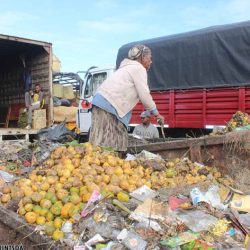The 80% of Malagasy are peasants. They produce agricultural products but constumers do not have enough money to buy them. As a result, many of their productions are rotten because of storage. The peasants lower their arms.
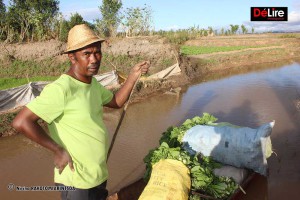
Gilbert Rakotoarison – Peasant of Ambohijafy
Madagascar will become an attic of the Indian Ocean. This is a long-term vision given the situation of the peasants. Agricultural waste amounts to 10% to 50% of the production intended for sale on the farmers’ market. Farmers do not yet have a method of preserving their perishable production. To avoid rotting, the goods should be sold in a short time depending on the variety of agricultural products. Our report focuses on the cultivation of agricultural products, rich in nutrients and providing an energy value for the growth and health of an individual. These are leafy vegetables, vegetables, fruits.
Ambohijafy, 18 km from the city of Antananarivo. Three peasants families were interviewed. Gilbert Rakotoarison and his wife harvest leafy vegetables around 11 a.m until 5 p.m. Every day, the couple pulls 15 bags of leafy vegetables. « On the spot, the products are transported with a small canoe (lakana). But they will be transported by bus when we sell them at the farmer’s market Namontana, in downtown Antananarivo. We left Ambohijafy at 9 p.m to reach Namontana. Sometimes this price goes down to 3000 Ariary. Farmers sell at a loss. During our reportage at the farmer’s market Namontana, the week of May 14, 2018, a peasant named Jeanne brought 10 bags of leafy vegetables, her sellers sold only three bags despite the price reduction.
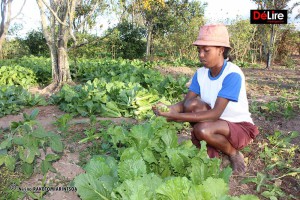
Tahina Mamy Ny Aina Mamisoa – Student
The eight o’clock in the morning, the payment is not yet complete against the peasants will leave the place at 9 o’clock. They will be replaced by retailers, depending on the organization of the market.
Ambohijafy, Tuesday, May 22, 2018 at 15:30, Tahina Mamy Ny Aina Mamisoa, a student has collected leafy vegetables for sale at the Anosibe market. She helps her parents harvest this agricultural product when she is not at school. « My parents sell it directly to Anosibe. Every day they will be there at one in the morning », said her. She collected two bags of leafy vegetables.
Purchasing power
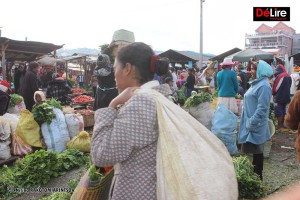
Peasant’s Market – Namontana
Given the situation in Madagascar, annual agricultural production is insufficient. Yet, a lot of waste of perishable agricultural product namely vegetables, leafy vegetables, fruits are thrown in the trash. Farmers and market sellers in Namontana and Anosibe complain that the sale was not perfect. As a result, the 10 to 50% of leafy vegetables and fruits are rotten. “Half of my leafy vegetables should throw in the garbage bin. Consumers do not have enough financial means as well as the stock of production is very high. The rotten products are recovered by the pig farmers or they will be thrown in the garbage. We are in loss « , told Hanta, peasant. On the other side, the rate of chronic malnutrition among children Malagasy is 47 %, according to the United Nations Food and Agriculture Organization (FAO). The highest rates are in the central uplands of Madagascar, particularly the Vakinankaratra region, the Analamanga region. Some Malagasy eat only rice or potato or corn or cassava all day long. By definition, malnutrition « refers to the situation of people whose dietary energy intake is insufficient to maintain a healthy and active life. The country profile of Madagascar shows that poverty affects two thirds of Malagasy. In combination with natural disasters, declining food availability and limited access to food, poverty results in high household food insecurity. Food availability is insufficient to meet the energy needs of the population of which more than a third is undernourished. Quantitatively insufficient, food supplies are also insufficiently diversified. We asked FAO Madagascar for an explanation of food security. She replied to us by email. « Food security exists when all people have, at all times, physical and economic access to a healthy, nutritious and quantity of food that allows them to meet their energy needs and dietary preferences for a healthy and active life ».
Improved technique
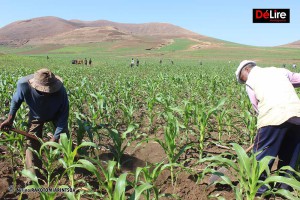
Peasants of Soavinandriana Itasy work with spades ( 148 Km from Antananarivo )
For lack of financial means of customers to buy vegetables, fruits … the recipes of merchants diminish. Rotten products are salvaged by pig farmers or thrown into garbage bins. Malnutrition will be eradicated if sustainable agriculture is practiced, the materials used by farmers are improved, access to land is allowed, farmers producers have mastered the technology.
Finally, but most importantly, farmers need markets to haggle their production and the population has the purchasing power. Climate change weakens the rate of agricultural production. A sustainable farming technique, namely agro-ecology, launched by the GSDM platform, solves this problem. Even if production increases but the population does not have the purchasing power, the waste of agricultural production will not be reduced. Therefore, every household needs to have enough money to buy healthy food.
The Malagasy state has a challenge to support Madagascar to become an « attic of the Indian Ocean ». This is a long-term vision because its population is still struggling to survive and faces daily for food autonomy.
Nirina R. and Lynda A.


